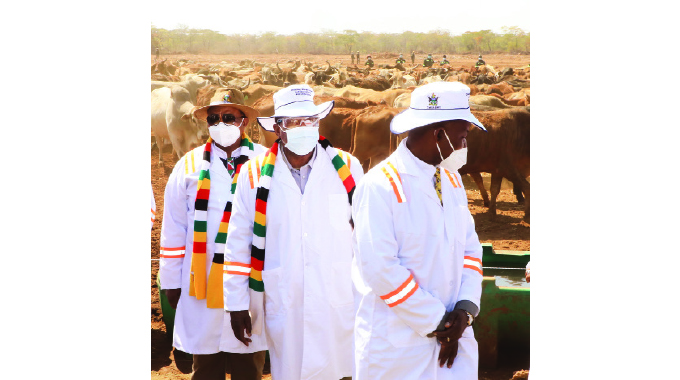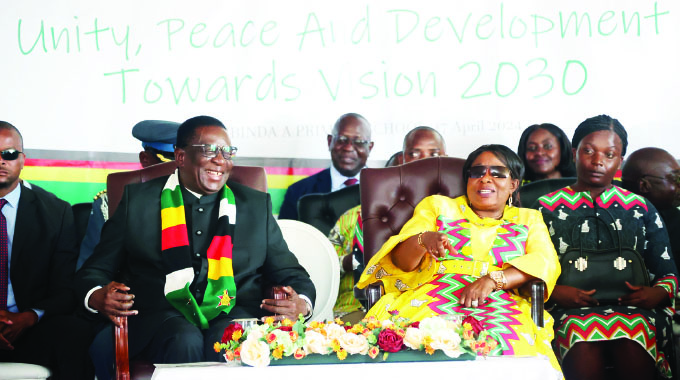US$15m cattle ranching project a game changer

Fungi Kwaramba-Political Editor
Private players should complement Government’s efforts towards achieving Vision 2030 by creating synergies with local communities and ensuring that no one is left behind in the process, President Mnangagwa has said.
This comes after Zimplats – a subsidiary of Australian listed Implats – established a multi-million dollar joint venture with Palmline Holdings in Mhondoro-Ngezi that is set to transform local communities in line with President Mnangagwa’s Zimbabwe is open for business mantra.
The project that the President commissioned yesterday demonstrates that despite illegal sanctions imposed by the United States and its allies, Zimbabwe is in partnership with progressive companies and countries in Africa and Eurasia within the framework of the National Development Strategy 1 economic blueprint which calls for a private sector-led development.
In spite of the sanctions, the country’s economy continues to defy odds with a projected growth of 7,8 percent, while institutions are being strengthened.
Speaking at the launch of the US$15 million cattle ranching project in Mhondoro-Ngezi, the President said the venture is a demonstration that the two mainstays of the country, mining and agriculture can co-exist.
“Today’s launch of the cattle ranching joint venture project gives impetus to the fulfilment of the Agriculture and Food Systems Transformation Strategy, which targets attainment of a US$8,2 billion agriculture economy by 2025.
“The fruition of the joint venture is a confirmation that sustainable and inclusive development of our great country is not only the responsibility of Government. It is a shared responsibility of the private sector, development partners and all citizens alike,” he said.
The project is part of the country’s efforts to boost the national cattle herd under the Livestock Growth Plan which seeks to grow the sector to US1,9 billion by 2025.
The Agriculture and Food Systems Transformation Strategy also anchors and propels Zimbabwe towards Vision 2030 to become an upper middle-class economy.
Under the scheme, increasing the cattle numbers from a 2019 baseline of 5,4 million to 6 million in 2025, with a beef production of 90 000 tonnes and milk production from 79,9 million litres to 150 million litres are some of the targets of the Livestock Growth Plan.
The programme also aims at increasing the national dairy herd from 38 000 in 2019 to 60 000 by 2025.
In Mhondoro-Ngezi the project will benefit local communities while other outlying areas such as Midlands and Matabeleland North and South and Masvingo provinces will also benefit.
The initiative targets a herd of 10 000 cattle comprising 5 000 beef and 5 000 dairy cattle.
Apart from that, there will be also semen production for both the domestic and export markets.
The beef cattle will consist of a commercial herd for domestic consumption and the high value Wagyu breed, for the export markets.
The President added that while the project will increase the national herd, it is also a critical step towards the production of 25 million litres of milk by 2026.
“The introduction of a dedicated 320 hectares of irrigated pasture is an emerging farming model which guarantees the availability of feed for livestock. Construction of a modular milk parlour with the capacity to handle 1 500 cows at one go, as well as processing facilities for export standard Wagyu beef is a welcome development in the modernisation of the sub-sector.
“The community development initiatives under this programme include the establishment of community paddocks and pasture improvement; roll-out of an artificial insemination programme for dairy and beef farmers to improve genetics; the swapping of old cattle with improved cattle breeds; provision of vaccinations and antibiotics targeting emerging pests and diseases, cattle dipping and skills development.”
Communities will also benefit under out-grower schemes through access to fodder grass and other stock feed such as maize and traditional grains.
The project also targets linking communities with high value markets for both beef and dairy products which should act as a motivating factor for both small and large-scale farmers to increase production and productivity.
“In order to ring-fence current and increased investment in agriculture, my Government remains committed to support the sector by constantly refining the present conducive policy and operating environment for the sustainable development of the sector.
“As enunciated in the NDS-1, this will be undertaken through measures such as strengthening farmer knowledge; skills in livestock production and health; continued roll-out of the blitz tick grease application programme for the control and eradication of diseases; as well as the modernisation and digitalisation of agricultural production systems.”
Government will on its part continue supporting farmers through the various farming support facilities such as the Government facilitated private sector-led silage production for the enhanced milk production programme for medium and large-scale dairy farmers, which is financed by the Agriculture Finance Corporation and CBZ Bank, small-scale dairy producers, the Presidential Silage and Forage Legume Scheme, which provides inputs for livestock silage and forage production.
“Given the anticipated benefits that are going to accrue from this venture, I am calling upon other private sector players to emulate the initiative by Zimplats and Palmline by responding to my administration’s call to come on board and invest not only in agriculture, but the other key sectors of our economy.”
Government, the President said, will accelerate the modernisation, industrialisation, and growth of the economy in collaboration with the private sector and other investors.
Livestock production in Zimbabwe is an important source of income and a safety net for hundreds of thousands of people, particularly rural women and youth, and is a significant contributor to agricultural GDP.
After the launch of the Livestock Development Plan, Government emphasised the importance of running the livestock sector as a business to ensure that it makes a significant contribution to Zimbabwe’s socio-economic growth.
Key strategies of the Livestock Development Plan entail an animal nutrition programme; a genetics improvement programme; an animal health programme; a climate change adaptation and small stock programme; the development of market and trade infrastructure; and resource mobilisation.







Comments